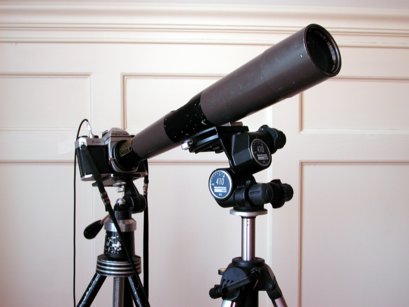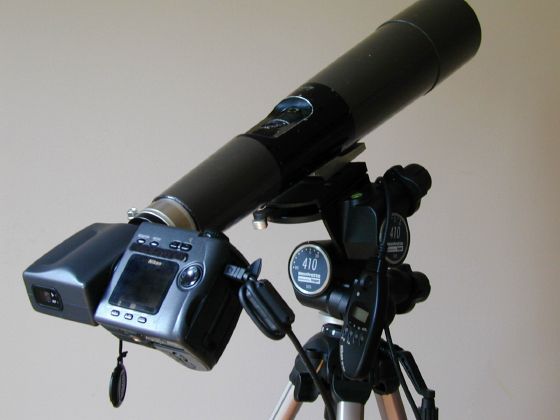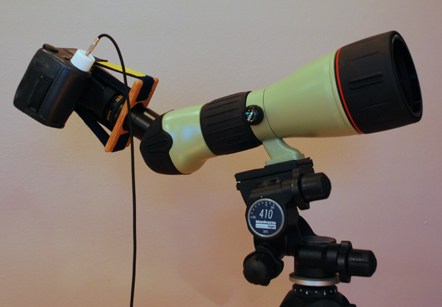The moon is a good subject for this camera lens because of it's brightness. However, exposure times were learned through trial and error since the black sky background confused the light meter in the cameras' viewfinder and shut it down. Here are some other complicating factors:
 The brightness varies with the phase of the moon. A full moon requires a much shorter exposure than a quarter moon. (The brightest part of a quarter moon is not nearly as bright as the brightest part of a full moon).
The brightness varies with the phase of the moon. A full moon requires a much shorter exposure than a quarter moon. (The brightest part of a quarter moon is not nearly as bright as the brightest part of a full moon).
 The camera exposure varies considerably with the height of the moon in the sky. No matter what the phase, the moon is brightest when it is at it's zenith, and is very dim just after it rises or before it sets.
The camera exposure varies considerably with the height of the moon in the sky. No matter what the phase, the moon is brightest when it is at it's zenith, and is very dim just after it rises or before it sets.
 Also, selecting the proper exposure for the moon is complicated because except for a full moon, the brightness varies from the bright outer edge to the dark shadowed side and you cannot properly expose all of it. I usually choose to expose for the craters and overexpose the rounded edge. See this example.
Also, selecting the proper exposure for the moon is complicated because except for a full moon, the brightness varies from the bright outer edge to the dark shadowed side and you cannot properly expose all of it. I usually choose to expose for the craters and overexpose the rounded edge. See this example.
 Basically the exposure is the same as a bright day, believe it or not! With ASA 400 film at f16 1/125 or even 1/250 of a sec is good. At f64 and 4000mm, a 1/30 second exposure got this shot.
Basically the exposure is the same as a bright day, believe it or not! With ASA 400 film at f16 1/125 or even 1/250 of a sec is good. At f64 and 4000mm, a 1/30 second exposure got this shot.
 The moon's apparent movement through the sky is quite evident at higher magnifications and appears as if the moon is traveling from left to right through the viewfinder at quite a noticeable clip. Here is a Quicktime movie showing this motion. Interestingly, a gentleman from Australia informed me that from downunder, the apparent motion of the moon would be from right to left.
The moon's apparent movement through the sky is quite evident at higher magnifications and appears as if the moon is traveling from left to right through the viewfinder at quite a noticeable clip. Here is a Quicktime movie showing this motion. Interestingly, a gentleman from Australia informed me that from downunder, the apparent motion of the moon would be from right to left.

 High magnification required two tripods. One for the camera and one for the lens. Try juggling those around as you're trying to focus on something that's constantly moving! Remember- this is purely low-tech. An astronomical tripod with a clock drive would avoid some of these problems, but I don't have one and I enjoy the challenge.
High magnification required two tripods. One for the camera and one for the lens. Try juggling those around as you're trying to focus on something that's constantly moving! Remember- this is purely low-tech. An astronomical tripod with a clock drive would avoid some of these problems, but I don't have one and I enjoy the challenge.
 Finally, getting the negatives developed was a hit-or-miss affair. I would get blue moons, brown moons, everything except a gray moon on a black background. And then, since the sky was black and the film unexposed there, the developer wouldn't know where to cut apart the negative strips. One of my best shots got cut right down the middle of the exposure!
Finally, getting the negatives developed was a hit-or-miss affair. I would get blue moons, brown moons, everything except a gray moon on a black background. And then, since the sky was black and the film unexposed there, the developer wouldn't know where to cut apart the negative strips. One of my best shots got cut right down the middle of the exposure!
 In 2001 I went with a digital camera mounted to the same lens and I had a great time with it. Only one tripod was necessary since there is no mirror flipping to shake the camera and I get extra magnification from the camera's zoom. Goodbye film and developing!
In 2001 I went with a digital camera mounted to the same lens and I had a great time with it. Only one tripod was necessary since there is no mirror flipping to shake the camera and I get extra magnification from the camera's zoom. Goodbye film and developing!

 2007: I upgraded the spotting scope to a Nikon Fieldscope 82. This is a big step up in quality of optics and the resulting photos are much sharper.
2007: I upgraded the spotting scope to a Nikon Fieldscope 82. This is a big step up in quality of optics and the resulting photos are much sharper.
Here are some examples of how this setup sees the planets.

Photo Gallery |
Home | Desktop Pictures
Moon Photos |
Radio Control Airplanes | Stereograms

